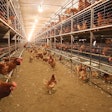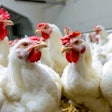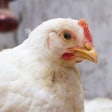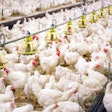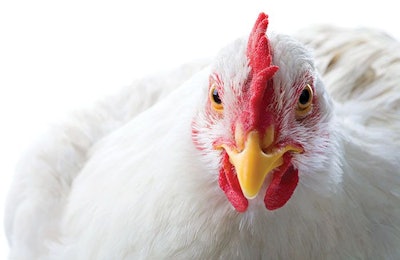
The chicken industry faces plenty of disruptions in 2018. Shifting consumer demands; more product on the market; international trade conflicts; and genetic challenges all raise tough questions.
As part of the 2018 Chicken Marketing Summit, WATT Global Media assembled a panel of experts to consider the turbulent times and how the industry can best cope. Dr. Mark Cooper, director of product testing for Cobb-Vantress Inc., Steve Sands, vice president of protein for Performance Food Group; James Sumner, president of the U.S. Poultry & Egg Export Council (USAPEEC) and Brian Coan, chief customer officer at George’s Inc., joined a panel focused on disruption and how the poultry industry can best deal with it.

Dr. Mark Cooper, director of product testing for Cobb-Vantress Inc., Steve Sands, vice president of protein for Performance Food Group, James Sumner, president of the U.S. Poultry & Egg Export Council and Brian Coan, chief customer officer at George’s Inc. formed the disruption panel at the 2018 Chicken Marketing Summit | Photo by Austin Alonzo
International trade: conflicts and opportunities
So far, 2018 is rife with trade issues rooted in political and economic conflicts. Due to this, the U.S.’ relationship with key trading partners like Mexico, Canada, the European Union and China is thrown into question.
Mexico
Sumner said despite the rhetoric, there’s no real harm done yet to the international trading partnerships concerning poultry with the notable exception of Mexico.
“There’s concerns in Mexico,” Sumner said. “We’ve had tremendous relations with Mexico and Mexico’s poultry industry for 20 some years, most of that has kind of gone down the tank.”

Jim Sumner, US Poultry & Egg Export Council | Photo by Austin Alonzo
Mexico, which received as much as a quarter of all U.S. chicken exports as recently as 2017, is now looking to source product from other countries and its eliminated import duties in order to facilitate the move. The U.S. is already losing considerable market share. In the last year, the U.S. lost 35 percent of the value of the market for chicken to Brazil.
The continued negotiations surrounding the future of the North American Free Trade Agreement will be key to the future of this relationship. Sumner said President Donald Trump plans on delaying any final negotiations until the November 2018 U.S. elections. Meanwhile, Mexico’s President-elect Andrés Manuel López Obrador – who’ll take office in December 2018 – is bringing an optimistic outlook to the relationship with the U.S. that his predecessor did not.
Finding new markets
As domestic production rises steadily in the future, the U.S. will need to find a home for the additional chicken meat. Sumner said a huge opportunity lies in India.
In March 2018, the U.S. opened up the poultry export market to the world’s second most-populous nation. It could potentially be an even bigger market for U.S. products than China. Sumner said the U.S. is effectively blocked from doing business with China, so India will be critical going forward.
USAPEEC is already facilitating meetings with Indian and American delegates to assess the market. The U.S. will face a 100 percent duty as well as a ban on feeding chickens any bovine products. But Sumner said exporters can work within those conditions and shipments of chicken products are already going into India.
Sumner said India’s consumers predominantly prefer live birds – as much as 95 percent of chicken is sold live – but high-end buyers like hotels and restaurants are currently interested in U.S. product. India may well move away from the live bird market in the future, too. There is optimism surrounding the future of the market. Sumner predicted it will grow slowly, but could be significant in the future.
Branding and marketing in the digital era
Consumers are now demanding greater transparency in the food supply chain. This, combined with animal activist pressure, is challenging companies to consider how they present themselves to the world. Now, chicken companies must ask themselves whether they can continue producing their product as a commodity, or whether it’s necessary to launch their own branded product to compete.
The advantages of building a brand
Sands, who spoke about Performance Food Group’s experience debuting a premium brand of beef, said the most important thing to do is to listen to the customers as they define what is best for them. Once that’s understood, a company can start to build a product or a brand to suit those needs. From a financial standpoint, the branded products are valuable. In beef and pork, branded products amount for 10 percent of PFG’s sales but they account for what Sands called a “much, much” higher percentage of the company’s earnings.
“It’s the most profitable part and the fastest growing part of our beef and pork program,” Sands said.

Steve Sands, Performance Food Group | Photo by Austin Alonzo
Furthermore, branding is another component of the storytelling and transparency that consumers crave. When the company is able to define itself and define what a desirable trait, like locality, means it gains a key advantage. If a company isn’t identifying who they are and what those traits mean, then the critics of the industry and the activist organizations will define it instead.
Why the chicken industry may hesitate to aggressively brand
Nevertheless, chicken is still a commodity business for many producers so branding isn’t valuable to everyone. Coan explained that this dynamic will play a role in how the chicken industry takes to branding in the future. Every company is different, he said, and will take a different view on issues like animal welfare or antibiotics use. That’s part of working inside of a free market and different companies will do what is right for them in order to gain an advantage or stand out from the crowd.
“I think there’s companies that from their start that were very purposeful about growing their brand, and then there’s also other companies that find it more cost effective to be in the private brands world,” Coan said. “So it’s a matter of, from your individual perspective, of where your company wants to play in that and do you want to put the dollars and resources in growing a private brand or grow your own brand.”

Brian Coan, George’s Inc. | Photo by Austin Alonzo
Coan agreed it’s important for the industry to tell its own story and provide customers what they want, but it’s also critical to keep in mind the consumer’s actual concerns. Still, he said, consumers are more concerned about hormones and steroids in chicken meat than anything else. Antibiotics is further down the list and broiler growth rates aren’t even on the radar yet.
Breeding challenges
A longer term hurdle for the industry lies in the genetics of the animal itself. On one front, activist-driven demands for a slower-growing bird are gaining clout as welfare pledges calling for a bird with daily weight gain limitations gain traction. On another front, the physiology of the bird itself is presenting difficult myopathies like woody breast syndrome.
The slow growing challenge
It’s inconclusive whether a slower-growing bird will provide a better welfare outcome, as its proponents claim, than a conventional breed. Cooper said groups committing to the slower growing bird – and a 50 gram per day weight gain limit – may be doing it without knowing if there’s any proven welfare advantage.

Dr. Mark Cooper, Cobb-Vantress Inc. | Photo by Austin Alonzo
A significant factor in the forthcoming trials comparing the breeds will be how the tests are set up and what criteria will ultimately be used to judge welfare. Cooper cited early work comparing conventional breeds to rustic, slower-growing breeds. Those trials showed the rustic roosters’ aggressive behavior toward females may be a welfare issue on its own.
Woody breast and other conditions
Cooper also explained the response to challenges presented by breast meat myopathies like woody breast or white striping. Geneticists are working to reduce the levels of these conditions in the finished product but the industry must recognize the importance of the growing program in the incidence of the myopathy. Growing environment, how the birds gain weight and what weight they reach before slaughter all play a role in the conditions, he said.
“It’s something that we need to take seriously. The breeding companies are taking it seriously, but it takes time to reduce the likelihood that that’s going to occur,” Cooper said. “Because that fights directly with breast meat percentage. As you push your breast meat percentages up, you really have to fight meat quality issues while you’re doing that.”
For now, breeders are selecting birds that avoid those conditions. But, solving the issue may ultimately require a combination of both on farm management changes and genetic modifications.
Join us in 2019
The 2019 Chicken Marketing Summit will be held July 21-23, 2019, at the Belmond Charleston Place Hotel in Charleston, South Carolina. The 2018 Chicken Marketing Summit was hosted at the Four Seasons Resort Orlando at Walt Disney World. Included in the record attendance of the 2018 Summit were attendees from 11 countries.










